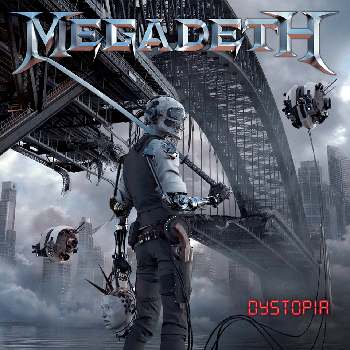It was a long time coming, nearly almost as long as it took for Scorsese to win an Oscar, but I digress. This February, Megadeth walked on stage at the GRAMMY Awards and finally got their due from the music industry’s most prestigious organization, a statue for “Best Metal Performance.” That it came for the title track of the band’s triumphant fifteenth album, Dystopia, must’ve felt even sweeter for members of the storied classic lineup indisputable Godfather of Thrash himself Dave Mustaine [vocals, guitar] and rhythmic genius David Ellefson [bass] and, of course, for the musicians that joined the dynamic duo in the studio Lamb of God’s Chris Adler behind the kit and Brazilian shredder Kiko Loureiro.
At this moment, Megadeth’s cultural impact feels more inescapable than ever. The ever-fantastic Damian Lewis just wore a Peace Sells… but Who’s Buying? t-shirt to a deposition on TV’s smartest show, Billions, as the song played in the background. Multi-platinum Dallas musical maverick Post Malone proudly sports a So Far, So Good… So What! tattoo and openly talks his love for the band. Examples continue to abound. As Megadeth gears up to roll out on the road with The Scorpions later this year, everything keeps coming back to Dystopia.
It’s a monster of an album. In fact, it’s everything a classic metal record should be and more. In the simplest terms, it’s the cross-section of the melodicism of the criminally underrated Youthanasia, the deft classically-inspired fret acrobatics of Rust In Piece, and the unmitigated youthful ferocity of Killing Is My Business… and Business Is Good! (which never, ever gets enough credit). Dystopia has it all. The shuddering “The Threat It Is Real” centers on an axis of calculated thrash riffing, bombastic drumming, airtight grooves, and Mustaine’s signature sneer. “Poisonous Shadows” may very well be the group’s most epic moment, building from classical guitar into an intoxicating whirlwind of powerful musicianship and an impenetrable crescendo. The title track twists and turns around an anthemic arena-size hook and so on and so forth…
It should be no surprise. If you go back to the beginning, this was always meant to be from Killing Is My Business… and Business Is Good! on. Go back to that early material, there’s an unmatched level of virtuosity and songwriting prowess. Who else can play and sing like that? Seriously, it’s like listening to Beethoven shred through a sonata on a Dean.
For as much as Dystopia may reference the legacy, it indicates an even brighter future. There’s still nobody like Megadeth, and there never will be.
By: Rick Florino



